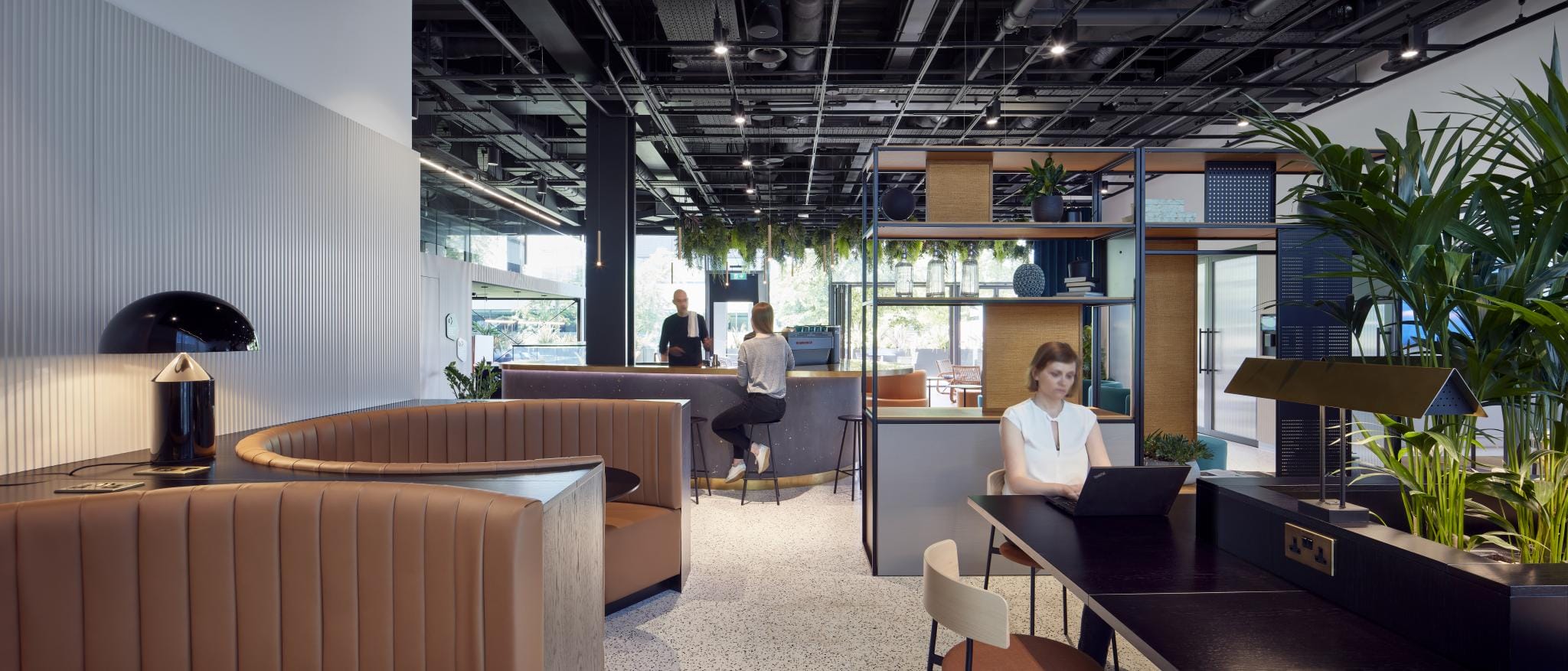

The stereotypical office – from the flickering fluorescents to the uniform rows of plastic, coffee-stained desks – hardly inspires creativity. However, the inverse is also true: a thoughtfully designed workplace can empower employees to focus, innovate, and do their best work.
Studies have found that ‘balanced workplaces,’ those that offer a variety of options for both individual and collaborative work, can have a significant impact on employee performance and productivity. Yet, according to Gensler’s study of US workplaces, just 44% of companies offer such an environment. Every workforce has unique needs, and so one-size-fits-all solutions can actually damage productivity.
Fortunately, designers have turned their attention to this issue. From internet-connected air quality monitors and lighting controls, to green spaces and environmentally conscious materials, here’s what we consider when creating the optimal workplace.
Variety
Different people want different things from their workspace, and some of their preferences are mutually exclusive, so how can an office keep everyone happy? The answer is variety. A range of options – from open to private, formal to informal, and noisy to quiet – allows everybody to choose the right place for them to work at any given time.
Leading companies in innovation are five times more likely to offer both individual and group workspaces, according to the Gensler report. The same report also found that 79% of employees with the choice of a variety of workspaces reported that they had a ‘great’ work experience. We understand that this choice makes employees feel empowered and boosts productivity, and it’s why we provide a number of options through our spaces including Storey Club, giving employees a range of options to suit their needs, moods, and day-to-day working styles.
Office spaces also need to be designed with consideration for the range of activities they host. They aren’t just offices; they’re also places for employees on their breaks to socialise and recharge. In fact, some of the best ideas come from colleagues chatting over coffee. At Google, they call these ‘casual collisions,’ and try to structure their offices to encourage them. Research by Haworth supports this idea, finding that support for innovation requires options for focus, relaxation, and everything in between.
Encouraging a balance between work and life maximises the chances of those invaluable casual collisions, and that’s why we’ve chosen office locations surrounded by a variety of options for employees looking to unwind. It’s the reason our workspace at 1FA Broadgate, is interspersed with a selection of restaurants, an Everyman cinema and Morag Myerscough’s striking Atoll installation.
Lighting
A recent study, conducted by Philips, reinforced the role of light in our circadian rhythms – our innate ‘body clocks’, which affect our sleep, stimulation, and relaxation. Studies have also linked lighting to depression, mood, alertness, and of course, productivity. Since many employees spend their days beneath artificial lights, it’s important that they’re right for our bodies.
Light temperatures range from ‘warm,’ yellowish light, to ‘cool,’ bluish tones. Warm lighting is best suited to intimate settings, such as breakrooms, as it creates a sense of relaxation and comfort. The middle of the spectrum is good for conference rooms and miscellaneous areas, as they strike a balance between comfort and alertness. Cool lights are ideal for brainstorming rooms, as they increase productivity and wakefulness, and lower fatigue by reducing melatonin. As with all things, variety is essential, and a range of lighting for various parts of the office can provide a sense of comfort and increase productivity.
However, as good as artificial lights can be, there is no substitute for natural light. It’s better for workers’ eyesight, mood, and energy levels. We considered this when choosing our Storey space at 19 Wells St, which has large, Art Deco windows that bathe the space in sunlight all year-round.
Biophilia
‘Biophilic design’ uses our instinctive affinity toward the natural world to put people at ease. This can be as simple as placing some plants around the office, but the field doesn’t stop there. A perfect example is a young designer we’ve been following named Julian Melchiorri. He won the Emerging Talent Medal at the 2017 London Design Festival for his creation of the world’s first living and breathing chandelier. It relies on novel bionic-leaf technologies which use biological micro-organisms and materials to convert waste and pollution into valuable resources.
According to the US Joint Commission, 40% of all sick leave can be traced back to indoor air pollution and poor air quality. Beyond the aesthetic benefits, greenery can significantly improve indoor air quality by absorbing pollutants, microbes, and spores. We have taken this to heart and designed Storey Club with a ‘conservatory’ space complete with succulents, designed in collaboration with a plant consultant.
Sustainability
Another critical consideration in office design is the space’s environmental impact. Fortunately, the Internet of Things (IoT) is making it easier to create smarter, more sustainable offices. These systems can be linked to activity tracking to ensure that only areas that are in use are being powered, further reducing waste.
The most substantial impact a building will have on the environment is during its construction. Waugh Thistleton, for example, has pioneered the use of sustainably engineered timber structures. By cross-laminating responsibly sourced timber, they can create structures with far less environmental impact, all while maintaining the highest standards for comfort and accessibility.
Designing an office that powers productivity
The environment that employees work in can make an enormous difference to the work that they do. From subconscious environmental factors like lighting to the happiness that comes from being able to choose the right space for the moment, considering the office space is crucial. Careful design is fundamentally important: the wrong environment might be leaving employees tired and frustrated, but the right environment can empower employees to be creative, to work productively, and to collaborate effectively.